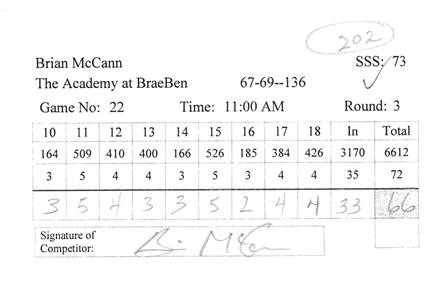
Golf Canada to Institute Changes to Equitable Stroke Control
Courtesy of Golf Canada
Oakville, Ont. (Golf Canada) – The Royal Canadian Golf Association (operating as Golf Canada) has announced a notable change to the Canadian methodology for calculating a golf handicap as it relates to Equitable Stroke Control (ESC).
The RCGA Handicap & Course Rating Committee recently approved a change to the long-standing Equitable Stroke Control (ESC) method, bringing the Canadian methodology into equivalency with current ESC calculations employed by the United States Golf Association (USGA).
The new Canadian methodology for Equitable Stroke Control will go into effect March 1, 2012 to coincide with the release of the 2012-2015 version of the Handicap Manual.
WHAT IS EQUITABLE STROKE CONTROL (ESC)?
Equitable Stroke Control (ESC) is the downward adjustment of individual hole scores for handicap purposes in order to make Handicap Factors more representative of a player's potential scoring ability. It sets a maximum number that a golfer can post on any hole depending on the player's Course Handicap.
HOW IT WORKS:
The modification to the current Equitable Stroke Control calculation is illustrated in the ESC table below:
CURRENT EQUITABLE STROKE CONTROL NEW EQUITABLE STROKE CONTROL
0 or Plus Course Handicap Maximum of 1 over par 9 or Less Course Handicap Maximum of 2 over par
1-18 Course Handicap Maximum of 2 over par 10-19 Course Handicap Maximum score of 7
19-32 Course Handicap Maximum of 3 over par 20-29 Course Handicap Maximum score of 8
33 and over Course Handicap Maximum of 4 over par 30-39 Course Handicap Maximum score of 9
40 and Over Course Handicap Maximum score of 10
WHY THE CHANGE TO ESC METHODOLOGY?
The RCGA Handicap & Course Rating Committee approved the change after commissioning statistical research which revealed that the current Equitable Stroke Control (ESC) method causes differences in Handicap Factors that are not necessarily commensurate with a difference in ability, particularly for golfers in the higher half of each range of handicaps within the ESC table.
A golfer with a 1 handicap, for example, should not be subject to the same ESC score adjustments as a player with an 18 handicap when their abilities are so different. By reducing the size of the handicap ranges within the ESC table, those issues are mitigated. The new ESC method provides a more even distribution across a wide range of handicaps.
IMPACT OF THE NEW ESC METHODOLOGY:
Using maximum numbers (rather than adjustments being based on hole-par) facilitates simpler application and comprehension of the Equitable Stroke Control (ESC) procedure. It also mitigates the affect of courses not allocating the proper par to holes as per RCGA guidelines.
Currently, in a head-to-head match, the lower handicap player has a better than 50% chance of winning. The new ESC will bring the odds closer to 50%.
The new ESC brings an RCGA Handicap Factor and USGA Handicap Index into virtual equivalency – an important consideration with the number of ‘snowbirds’ playing golf in certain parts of the United States during the winter months.
Canada will continue to use ‘Handicap Factor’ as the proper terminology related to handicapping.
Golf Canada will be communicating the changes to Equitable Stroke Control methodology to all Canadian golf industry groups including golf clubs that use Golf Canada’s Handicap Network and golfers that track an official handicap in advance of March 1, 2012.
CANADIAN GOLF HANDICAPPING – BY THE NUMBERS:
In 2011 alone, more than 350,000 golfers who maintain an official RCGA Handicap Factor posted close to 7 million scores through the Handicap Network portal on www.golfcanada.ca.
GOLF HANDICAP – DEFINED:
A handicap in golf is a numerical measure of a golfer's playing ability based on the tees played for a given course. A handicap is used to calculate a net score from the number of strokes actually played, thus allowing players of different proficiency to play against each other on an equitable basis. The higher the handicap of a player relates to lesser golfing abilities relative to golfers with lower handicaps.